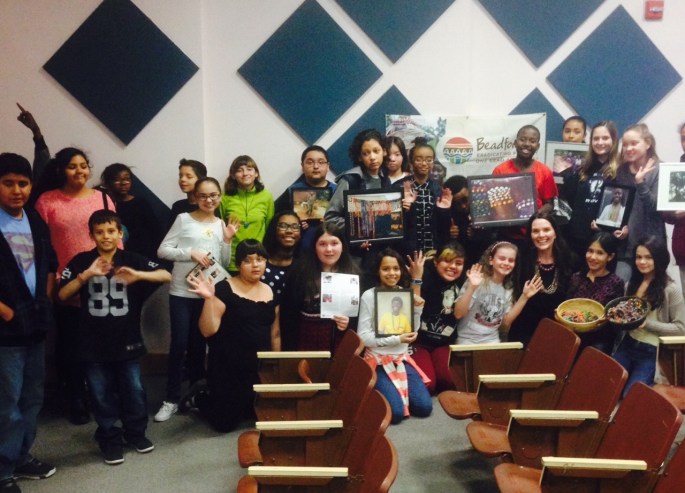How did they treat you when you were in Uganda? asked an 11 year old student with an inquisitive mind. Did they treat you differently because you are a different race?
What were you most afraid of during your stay? Did you go there alone?
Why were there no boys or men in the video on extreme poverty?
These are just a sampling of the many questions asked during the 3 presentations given on BeadforLife and extreme poverty at Johnson Junior High, a recently named international academy here in Las Vegas. Students from 7 different social studies classes were invited to participate in an exciting forum last month to learn about daily life in extreme poverty, in particular, life in Uganda.
Prepped with recycled paper beaded jewelry, photos of the women in BeadforLife’s programs, statistics on extreme poverty in both Uganda and the U.S., I apprehensively entered a Jr. High auditorium where I would be challenged with the task of building bridges of understanding between these young, developing minds with those who live thousands of miles away in a developing land- one very different from their own. I had no doubt I would leave at the conclusion of the day feeling I was blessed with an opportunity to learn as well. I recall distinctly the BeadforLife mantra taught in the Street Business School program that both student and teacher are called, “coach”, suggesting the reciprocity of learning.
Entering the stage of critical thinking is … well, entering a world of mental capacity expansion. Allowing the brain to stretch in ways previously unknown. Pausing to consider another’s perspective for just a moment in time. Allowing space to contemplate another’s reality, perhaps harsher or just different than your own. This is the beauty of learning, as once the new information enters the mind, it sets up camp, impatiently calling us to kick it around like a ball in a game of mental hackeysack.
As the 2nd guest speaker these students had ever encountered in a classroom environment, I felt a strong desire to impact them in a way that would challenge their thinking, create a hunger to learn more, and potentially inspire some to embrace their role as global citizens in the world, recognizing their voice and ultimate impact their voice has on the eradication of extreme poverty. Tall order for 6th graders you may be thinking… but in actuality, the elasticity of their minds is incredible!
I was so impressed with some of the students’ answers when I asked questions like, ” What impact does being paid a fair trade wage have on people living in extreme poverty?” and “Why do you suppose women and girls were the focus in the brief BeadforLife video we just watched?” I especially loved hearing their responses when asked to share what looked different in the daily life in Uganda compared to daily life in the USA. Sugar, they learned, was a luxury not a necessity for living. As for electricity, only 15% of the country of Uganda has access to it. Homes, they grappled to comprehend, were a mere 10 ft x 10ft for an average family of 6-8 people, and didn’t include running water for things like brushing teeth or quenching thirst. We talked about fears, and how everyone has them, they are just different based on geographic and socio-economic positioning.
In efforts to connect the kids to people in extreme poverty, I shared BeadforLife’s belief that no matter where you have been in life, how dire your circumstances past or present, there is a way out. There exists an opportunity for change in life. It’s there for the taking, provided initiative and desire are present to seize the opportunity. Like teachers at Johnson Junior High School to their students, BeadforLife takes a mirror and shines it in the faces of the downtrodden and says, ” I BELIEVE IN YOU!”.

It is not enough for people to survive. Everyone has the right to THRIVE. The Millennium Development Goals, now called the Sustainable Development Goals seek to end extreme poverty by the year 2030, reminding us that we can see an end to extreme poverty in our lifetime. This will happen as a result of our youth exercising their influential 1st world voices.
After reading hundreds of thoughtful, hand-written thank you notes from the students the past couple of days, (thank you Mrs. Stice, Mrs. Johnson, and Mrs. Slighting ), I see the spark and potential in the youth of our future. I see the impact that a little bit of knowledge and understanding can have to make our world a better place, one step at a time.



A friend of mine shared an interesting article from Outsideonline.com that sited the USDA:
The average family of four trashes 2 million calories a year- worth 1,500$. As a result, 25% of America’s water is used to produce food never eaten, and an estimated 28% of our planet’s agricultural land used to grow food ends up in the garbage. Food is the single largest solid waste component of America’s landfills, at an estimated 80 billion pounds- and emissions from it are equivalent to greenhouse gas output of 33 million cars.
Now that is some food for thought.

